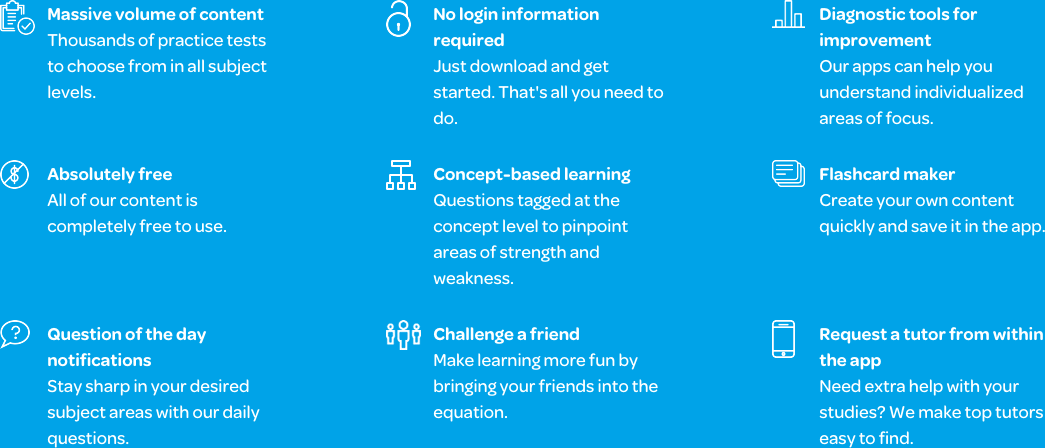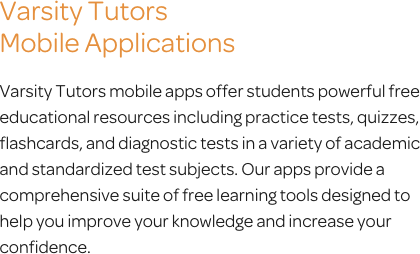The Varsity Tutors SAT Mobile App
When preparing for the SAT, it may be important that you know which colleges you will be looking at and what their SAT requirements are. The Varsity Tutors SAT Prep app for iPhone, iPad, and Android devices is an essential tool for SAT preparation. It’s best to aim for a higher score than necessary, just to make sure you meet the standards of the school you want to attend. Having a goal in mind helps you prepare for the SAT; as you progress, you will know when you are ready for the real thing.
The SAT Prep app guides you through each section of the test in a logical and comprehensive way. In the Critical Reading section, the first set of questions are passage-based. These are split up into the subjects of humanities, literary fiction, natural sciences, social science, and history. Then, you will encounter the sentence completion questions, which test you on specific parts of speech and general grammar skills.
The SAT Math section includes questions on algebra, arithmetic, data analysis, and geometry. The app walks you through these subjects in great detail, including right triangle skills like finding angles, similarity, area, hypotenuse, perimeter, and side lengths. The app also covers topics as diverse as parallel lines, how to calculate the amount of sales tax on an item, and how to work with polynomials and trinomials.
The SAT Writing section will test you on identifying sentence errors in agreement, phrases and clauses, punctuation, and word usage. It also tests your ability to improve paragraphs and sentences by analyzing, combining, and moving content. Finally, it will test your aptitude for correcting errors in grammar and punctuation, including conjunctions, modifiers, and commas.
As you are studying, you can use the Learn by Concept resource to study a broad section of the test or to drill down into a specific topic. You might be interested in learning to describe the tone of a humanities passage, or how to find a rational number from an exponent. You can also go through the topics of an entire section of the test using the Learn by Concept tool.
If you’re not sure what you need to work on, take one of the full-length, timed practice tests. You will receive a comprehensive report of your performance, including scoring information, solving times, and more. There are also detailed explanations that accompany each question. You can take one of these tests, study up on the concepts you need to review, and then take another test to measure your progress. With the built-in Test Tracker, you can record the scores of your practice tests and watch your progress as you grow closer and closer to being prepared for the SAT.
The flashcards are also a great tool. There are sets ranging from broad overviews of a test section to very specific topics. You can also make your own cards with the Flashcard Maker, using custom images, audio, and text for a truly individualized learning experience.
Be sure to download the free Varsity Tutors SAT Prep app from iTunes or the Google Play Store today, and get started on studying for the SAT!
66 mobile apps to choose from for your tutoring needs.

Learn More
Many post-secondary institutions use the SAT, an admissions exam, to assess your preparation for college-level academics. Your SAT score is often a big component of determining your acceptance to the university of your choice, alongside class rank, high school grades, recommendations, extracurricular programs, and community service.
There are three core areas that the SAT tests your capabilities in: writing, reading, and math. Usually, you take the test twice; once in your junior year, and once in your senior year. Each section is timed, with an overall 3 hours and 30 minutes to complete the full exam. Each section focuses on concepts and topics that you learned during your high school years. The three sections are each scored between 200 and 800. The essay you write for the last portion of the exam is scored based on a scale of 2-12. In addition, you have a 10-question multiple-choice section that scores between 20 and 80. The day you take each subject depends on your school and school district schedule, though some institutions arrange for the full exam in a single school day.
The Critical Math portion of the SAT assesses your abilities in a wide range of mathematical problems. You will primarily see questions that place a heavy focus on algebraic skills, strategic tool use, and forming models. The SAT questions you'll see encourage real-world thinking to mirror the types of modeling and problem-solving you could expect to see in college-level science, math, and social science classes; current and future jobs; and your personal life. You will need to be able to solve problems that require you to chain together multiple steps, work with multiple-choice and grid-in questions, expand scenarios to solve multiple questions, and know when to work without your calculator. There are many concepts you will be tested on that come into play during college-level programs, such as linear systems and equations, quantitative literacy, and solving complicated equations. In addition, you will see questions that require skills in trigonometry and geometry.
When you take the Writing and Language section of the SAT, you will need to be detail-oriented to catch every little mistake. Through numerous multiple-choice problems, you will be instructed to read a variety of passages before answering the problems. You may see problems that use graphics, such as charts or tables, to support their evidence, though there are no calculations needed for this section. You may need to read a full passage thoroughly before answering a question, identify a misinterpretation of a graphic, or choose a statement that better demonstrates the graphic’s importance. This section of the test works to assess your capabilities in a number of areas, such as your ability to use evidence to your advantage; improve words in a specific context to benefit the passage in tone, style, or syntax; skills in expressing ideas in a clear and organized way without sacrificing impact; and your understanding of sentence structure, punctuation, and usage.
The Reading section of the SAT measures a great deal more than many people realize. This section is made up of passage-based multiple-choice questions. Some passages must be read alongside others. In addition, you may see graphics and other tools on this section. When you read, you are expected to employ multiple skills, such as your ability to identify evidence that supports the authors claim, backs up an answer, or has a relationship to a passage. In addition, this portion can assess your grasp of various words based on their context. For instance, you may need to use clues in the passage to identify the definition of a word or express how the author shaped their tone, meaning, and style through word choice. You'll come across passages that relate to science, social studies, and history. Though you will not be tested on previous knowledge in these subjects, the reading portion of the SAT assesses the reading and comprehension skills you will need to have in order to succeed in these areas when you get to the college level. You may be asked to interpret a set of data, identify the meaning behind evidence, or look into hypotheses for validity and value. This section of the SAT always has a passage from contemporary or classic US or world literature; a section based on a social science like psychology, economics, or sociology; a passage or two from the US Constitution or other US founding documents; and two passages based on science to discuss biology, physics, biology, or Earth science.
When you begin the Essay section of your SAT test, you will need to use a combination of writing, reading, and analysis skills to succeed. The essay portion is designed to mimic college-level writing assignments. It is an important section since nearly every college-level program will require some degree of writing. You receive 50 minutes to read the passage; craft an explanation about the author's argument and how it was used to persuade the audience; and use evidence in the passage to support your claims. Through this, the test is able to assess a variety of necessary skills, such as your ability to identify and use evidence; how you can develop well-reasoned ideas; and your ability to understand persuasive or stylistic aspects, such as word choice, emotion, and ideas. No matter when you take the SAT, the prompt is primarily the same. The passage will usually be written to appeal to a broad audience; revolve around political, cultural, civic, or artistic ideas, trends or debates; base its claims on logic and evidence; and express views subtly.
When you are preparing to take your SAT, it is important to understand that you aren't doing anything you haven't done before. The skills you will be asked to demonstrate are simply to ensure that you are ready to attend college-level programs. It can play a role in getting accepted into the institution or school program of your choice. In addition, it can be a good idea to take the test every opportunity you have. The schools you apply to will always use your highest score on the exam to assess your preparation. Through this exam, you can open doors to a brighter future.




